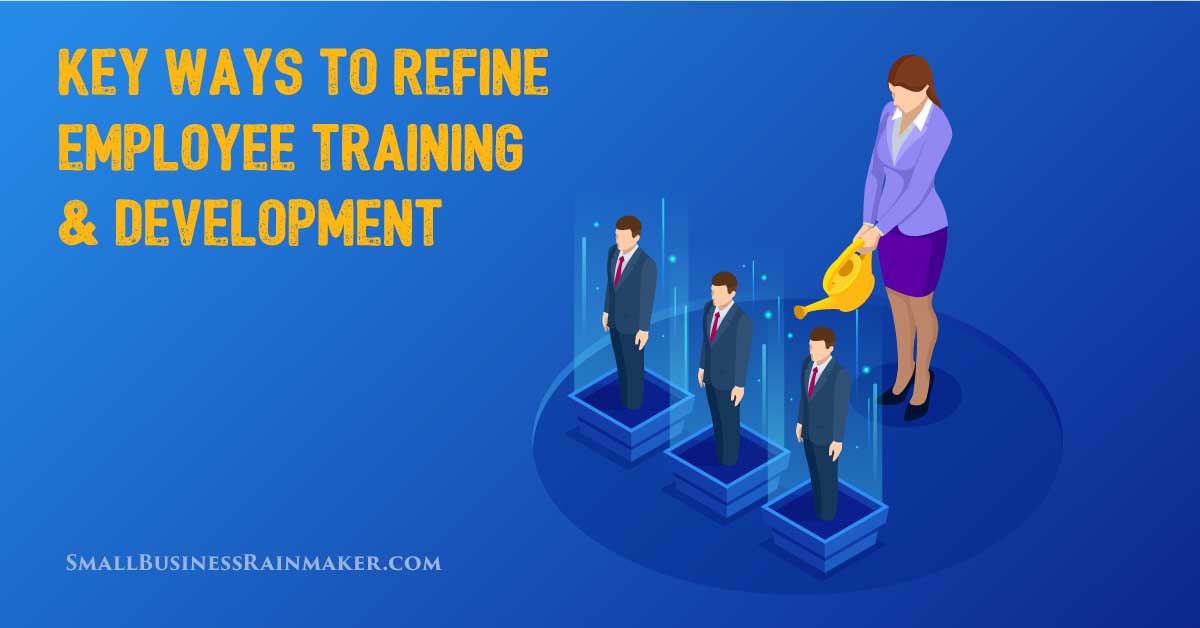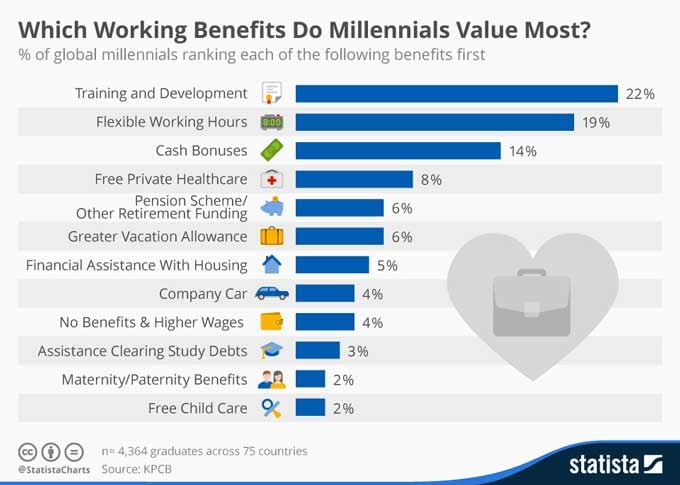
Did you know that training and development programs are among the benefits that young professionals value most? In order to keep up with the demands of a rapidly changing workforce, it is vital, as a business owner, to invest in a quality training and development program.
 Source: Statista, Which Working Benefits Do Millennials Value Most?
Source: Statista, Which Working Benefits Do Millennials Value Most?
Effective Training Techniques and Development Plan Ideas for Employees
Let’s take a look at 7 key ways to improve your employee training and development programs.
1. Assess Your Employees’ Wants and Needs
Any good training and development program begins with an assessment of your organization’s workforce. Identify where professional development needs to happen. Employees themselves are often the best place to get this information. Employee motivation, such as opportunities for career growth, is also particularly important to consider.
Outside of one-on-one meetings, surveys and focus groups are some of the best tools we can use to discover what motivates our employees and what they think can be improved with learning and development programming.
2. Align the Training Program with Your Company’s Goals
Alignment between organizations’ broader goals and their respective learning and development (L&D) initiatives is absolutely crucial. This synergy is vital when it comes time to demonstrate a training program’s value.
However, research by Chief Learning Officer shows that this essential connection is often absent for many organizations. Only about 8 percent of L&D professionals believe their mission is aligned with company strategy; just 27 percent of HR professionals find there to be an adequate connection between their company’s business objectives and their department's learning KPIs.
Chief Learning Officer defines alignment as “the proactive, strategic process of planning learning to directly support the important goals and needs of the organization. L&D leaders and organization goal owners need to agree on the target audience of the learning initiative, timing, type of learning, objectives, cost, and measures of success.” If your training program aligns with specific company goals, your company will be able to conduct more targeted post-training assessments.
MicroTek outlines the seven most important categories of KPIs that assess training program effectiveness:
- Knowledge retention and application
- Operational effectiveness measures
- Employee performance measures
- Departmental performance
- Number of employees trained
- Time to training completion
- Learner satisfaction
The data obtained from developing training KPIs will help you find out what to ask learners after the program has been completed and what specific performance criteria to gauge, ultimately making it possible to evaluate post-training operational effectiveness more accurately.
3. Communicate Well and Be Transparent
This one should be a no-brainer, but it’s surprising how often it’s overlooked. Before launching any training program, your training objectives, purpose, and expectations should be outlined unambiguously. If there are any changes in policy during the course of training, these need to be communicated clearly as well.
4. Provide Hands-On Coaching and Mentoring
Harvard Business Review writes that managers today “no longer pass-on knowledge, skills, and insights through coaching and mentoring. Organizations need to support and incentivize managers to perform this work.”
Managers with little experience find coaching particularly intimidating. Modern-day employees, especially millennials, demand more than just being told what to do. To provide an incentive, ask them the following simple questions on a weekly basis:
• Are there any issues you’re struggling with? How can I help?
• What would be helpful for you to learn?
• What is a measure you can take to improve your overall performance next week?
Why is inquiry important? Simply put, our employees are our organization. They want to know that their managers are committed to supporting their professional and personal growth. While it’s a process, employee development also leads to short-term benefits like improved engagement, performance, and increased loyalty.
Formal employee training may be required to achieve competency and outstanding performance. As we grow our teams, it’s helpful to create a collective knowledge base of important information, insights, and good practices to pass on to new staff members. Training manuals should be reserved for outlining formal procedures and basic tasks.
5. Outsource Meeting Rooms and Venues
A study conducted by IBM showed 68% of employees prefer to learn on the job and 58% wanted to be able to learn at their own pace. Attending a conference or event, taking part in in-person training, and working alongside knowledgeable colleagues are millennials’ top 3 preferences for learning new skills. This is important to consider when devising employee training and development programs, as millennials comprise the vast majority of today’s workforce.
6. Keep Innovating as the Workforce Evolves
Be up to speed with the latest technology and trends to stay relevant. Successful talent management requires the flexibility that only digital training or hybrid solutions can offer. Today, about 90% of companies offer some form of digital learning in their organization. While remote and virtual work has its benefits, training these employees requires more creativity and a larger financial investment. This includes informal mentoring and coaching channels as well as conventional types of learning, such as in-person courses.
7. Measure Your Results
To measure your results objectively, we recommend applying the tried-and-true SMART principle: Specific, Measurable, Ambitious, Realistic and Time-specified. Specifying realistic, measurable, and ambitious goals is no easy feat, but the effort will pay off.
In fact, it’s actually an unavoidable exercise, as it would be impossible to assess the outcome of a training program without specific, measurable goals.
General goals like “improving productivity” just don’t work. A more specific and measurable goal would be “reducing employee absenteeism by 10% before the end of the fiscal year.”
When helping your company articulate its goals, ask the following questions:
• What are the company’s actual goals? What do we want to achieve?
• Do we dispose of data that we could use as an indicator of goal achievement?
• How will the data be collected and reported and who will be responsible for this process?
To avoid the proverbial “paralysis by analysis,” use a small number of specific goals.
Knowing the Value of Learning is Not Enough
As company leaders, we know how valuable learning and development programs can be, but only through thoughtful implementation can we truly harness that power to grow our businesses. Choosing the most suitable and targeted solutions to generate results, constantly adapting alongside industry innovations, and continuing to create opportunities for employee engagement in the process ensures we’re maximizing the impact of our L&D programming.
 Mercy Ehrler has been marketing for corporate events and learning organizations for more than 15 years. She is currently the Director of Marketing at Attune, a global leader of meeting and training venues, virtual collaboration solutions, and end-to-end event coordination services. Ehrler’s extensive background in the industry has given her unique insight into the challenges faced by organizations when developing and executing corporate events. Drawing on this experience, she helps shape Attune’s positioning of its innovative meeting and training delivery solutions.
Mercy Ehrler has been marketing for corporate events and learning organizations for more than 15 years. She is currently the Director of Marketing at Attune, a global leader of meeting and training venues, virtual collaboration solutions, and end-to-end event coordination services. Ehrler’s extensive background in the industry has given her unique insight into the challenges faced by organizations when developing and executing corporate events. Drawing on this experience, she helps shape Attune’s positioning of its innovative meeting and training delivery solutions.














Leave a comment